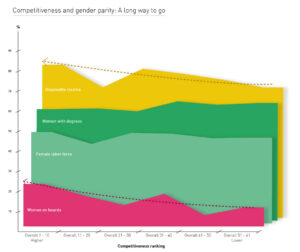
Competitiveness and gender parity
March 8 marks International Women’s Day: a celebration of the many accomplishments by women as well as the acknowledgement of on-going efforts for gender parity in the social, political and economic spheres. In this issue of the Criterion of the Month, the IMD World Competitiveness Center recognizes the International Women’s Day by exploring the relationship between competitiveness and different criteria related to women’s activities.
To explore this relationship we group the countries according to their position in the latest Competitiveness Ranking. In the graph below, the first set of countries in the horizontal axis represents the ten highest ranked economies, followed by the second ten and so on. The percentage of women in the total work force of a country defines the “Female Labor Participation” criterion. Even though the criterion ranges from about half to a little more than 10% of the total work force in the economies we study, when we aggregate the values for each competitiveness group we find that it remains more or less constant irrespective of the competitiveness ranking of the country.

A consequent question is related to the skills of the female labor force. An indication of the availability of skills can be approximated by the percentage of female graduates of tertiary education. The criterion of “Females with Degrees” ranges from almost 70% to about 47% in the economies we study. Similarly to the earlier criterion, when we examine the aggregate values we also find that the percentage of women with degrees is independent of the competitiveness ranking of a country. In fact, the number of women with degrees is higher in the least competitive economies. This has a positive side implying that women with skills are present in all the economies we study. But, are women able to contribute to the economic performance of a country?
Substantial research has been undertaken to address this difficult question. Within our indicators we can approximate this inquiry by considering the percentage of women who are members of Boards. This criterion ranges from around 40% to…zero. A clear relationship can be seen in the graph: A high percentage of “Women in Boards” is observed in high ranked economies with respect to competitiveness. The average of the female board members in the ten most competitive economies is almost 21% whereas in the ten least competitive economies is only 7%. Thus, given the availability of women with degrees, economies must integrate the skills and competencies available to them more effectively.
Does the participation of women in leadership capacities translate to higher remuneration? To address this point, we can look to the “Disposable Income” indicator. This criterion measures the ratio of female to male disposable income and ranges from about 94% to only 18%. When we calculate the average values for the groups under consideration, a relationship once again is identified: income gender parity is higher in more competitive economies. More specifically, the ten most competitive economies have a 77% ratio compared to 65% for the ten economies ranked the lowest.
In sum, women’s labor participation is more or less the same irrespective of the competitiveness ranking of the economies
The same holds for the percentage of women with a tertiary education degree. This pool of skills, however, does not seem to be integrated in the same way throughout the economies we study. In fact, women take more leadership positions in more competitive economies translating into higher disposable income for them. Less competitive economies are slower in giving ample recognition to the most highly skilled female members of the workforce.
Looking back from the initial celebration of the International Women’s Day over a century ago, the accomplishments to date are significant and profound. However, there is still substantial room for improvement that may lead to higher levels of competitiveness, and therefore, in higher sustainable value creation for the countries.
Research Information & Knowledge Hub for additional information on IMD publications
To understand America’s aggressive shift on trade, you must first grasp the silent, slow building, decades-long erosion of American middle-class prosperity. This shift began well before President Trump and will outlive him. It is rooted in the col...

In President Trump’s second term, a variety of executive actions have reversed social progress. Withdrawing from the Paris Climate Agreement presents a significant challenge to bending the global emissions curve since it is one of the world’s larg...
in I by IMD
Research Information & Knowledge Hub for additional information on IMD publications
in I by IMD
Research Information & Knowledge Hub for additional information on IMD publications
in I by IMD
Research Information & Knowledge Hub for additional information on IMD publications
in Gensler, Gary (Ed.); Johnson, Simon (Ed.); Panizza Ugo (Ed.); Weder di Mauro, Beatrice (Ed.) / The Economic Consequences of The Second Trump Administration: A Preliminary Assessment, pp. 239-244 / PAris: CEPR Press, 2025
Research Information & Knowledge Hub for additional information on IMD publications
Published by International Institute for Management Development ©2025
Research Information & Knowledge Hub for additional information on IMD publications
in I by IMD Brain Circuits 17 June 2025
Research Information & Knowledge Hub for additional information on IMD publications
in I by IMD
Research Information & Knowledge Hub for additional information on IMD publications
in I by IMD
Research Information & Knowledge Hub for additional information on IMD publications
Research Information & Knowledge Hub for additional information on IMD publications
in Stanford Social Innovation Review Online 2 June 2025
Research Information & Knowledge Hub for additional information on IMD publications








